 |
 |
|
 |
Governor-elect visits CO with message: fund roads, transit with bonding |
 |
 |
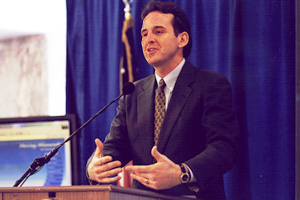 |
Gov.-elect Tim Pawlenty addresses Mn/DOT employees in the Transportation
Building on Dec. 5. Photo by Dave Gonzalez
|
Gov.-elect Tim Pawlenty and Lt. Gov.-elect Carol Molnau visited Mn/DOT’s Central
Office Dec. 5 to "gather impressions," discuss the recently announced
projections of a $4.56 billion state revenue deficit, and propose bonding as
an alternative to raising taxes for transportation projects. They also came
to hear about some of Mn/DOT’s accomplishments.
Their visit drew Mn/DOT employees from the Central Office, the districts and
Metro Division to join the gathering in the first floor lobby. In a first for
Mn/DOT, employees in the districts and Metro also saw the live broadcast via
teleconference.
Pawlenty began by calling the deficit "a structural problem, the fiscal
equivalent of a tornado or a flood or a natural disaster" and a "very
substantial challenge for the state of Minnesota."
"We’re not going to be pointing fingers about how we got here," he
said. "We’re going to accept responsibility for having to solve the problem.
This is Minnesota. We rally around each other when there are tornadoes, when
there are floods, when there are natural disasters. We will solve this problem
and there will be better days ahead."
The deficit does not impact Mn/DOT as much as state agencies that draw heavily
from the General Fund, Pawlenty said, but warned that state tax revenues could
lag behind the economy for a few years. He proposed issuing bonds to raise more
money for transportation projects. He did not, however, see massive layoffs
as the answer, stressing retirements, attrition and reorganization.
"I want you to know that we also realize that this budget deficit cannot
be balanced on the backs of state employees," he said. "We could lay
off lots and lots and lots of folks and not even come close to solving the budget
deficit."
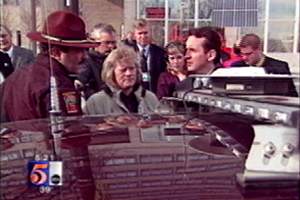 |
Gov.-elect Tim Pawlenty and Lt. Gov. elect Carol Molnau checked out
a State Patrol car and Mn/DOT's high tech Safeplow during their Dec.
5. visit to the Central Office.. Photo courtesy of KSTP-5 TV
|
Both Pawlenty and Molnau expressed appreciation for state employees’ work,
stressed their talent search for "change agents, people who embrace change"
and urged employees to propose improvements. Pawlenty closed by saying that
he expected to announce the next commissioner of transportation by the end of
the year.
Following Pawlenty’s presentation, Doug Weiszhaar, acting commissioner, talked
about some of Mn/DOT’s improvements to its processes and services.
"In the past two years we’ve found more than 50 ways to streamline the
construction schedule," he said. Examples he cited included the design-build,
best-value process used to shave years from completion of rebuilding the Hwy
52 corridor in Rochester along with other design-build projects.
Weiszhaar also pointed out service improvements such as living snow fences,
anti-icing techniques and activation of the 511 traveler information service
as examples of how Mn/DOT saves time and resources while improving customer
service.
Videotapes of the visit are available from district and Metro Division public
affairs coordinators as well as from the Mn/DOT Library.
By Marsha Storck
|
back

|
 |
Joint dispatch centers bring closer ties for Public Safety, Mn/DOT |
 |
 |
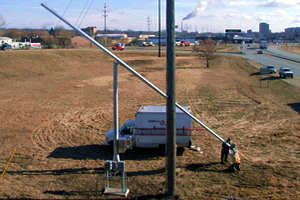 |
Work crews install traffic monitoring cameras along Hwy 52 in Rochester
to help dispatchers better manage traffic on the busy roadway. Photo
by Brian Jergenson
|
Just a mile or so from their quiet, softly lit control room in the Rochester/
District 6 headquarters, crews are testing traffic management equipment on Hwy
52 that can significantly increase the effectiveness of Faith Mendoza and her
co-workers.
When the traffic monitoring cameras and changeable message signs start working
on Hwy 52, Mendoza, radio communications supervisor, and other Department of
Public Safety dispatchers will have another tool to help them improve safety
and traffic flow in the busy corridor that runs through the heart of Rochester.
The system on Hwy 52 will link the dispatchers with eight traffic cameras and
six changeable message signs. The new equipment will support their role as full-time
dispatchers (technically radio communication operators) for both DPS and Mn/DOT’s
Rochester District.
"We’ve been doing joint dispatching since 1998," Mendoza said, "but
the new agreement and new technology will enable us to do a better job of informing
the public about traffic conditions and events such as road closings and will
improve safety."
DPS operators handle dispatching for Rochester on a full-time basis now instead
of 16 hours a day (the night and swing shifts) as before. This change took place
Oct. 15 as part of an agreement by Mn/DOT and DPS to create an integrated statewide
communications and transportation operations network that will serve rural and
smaller urban areas outside the Twin Cities metro area.
The direct link between DPS and Mn/DOT enables dispatchers to, for example,
contact a maintenance employee directly to provide support at a crash scene
or other support for State Patrol officers. Conversely, officers can report
road conditions directly to the dispatchers for posting on the Minnesota Condition
Acquisition and Reporting System.
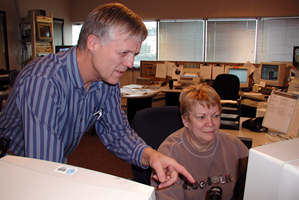 |
Dean (Corky) Cummins, maintenance superintendent at Duluth, confers
with Marge Kangas, DPS radio dispatch supervisor at Duluth. Photo
by Maureen Talarico
|
Known as Transportation Operation Communication Centers, the facilities will
serve as regional centers for 24-hour incident and emergency response, multi-agency
dispatching and fleet management, interagency communications, collecting and
reporting road condition information and traffic management. The expanded TOCC
network will improve communication between each department and improve services
for motorists.
"We had monthly Operations Team meetings to work out details of software
functions, computer hardware, system integration and other issues," said
Mike Schweyen, Rochester district traffic engineer and ITS project manager.
"Our meetings, with Faith’s input, helped the team visualize and define
the dispatchers’ needs for making the system work for them."
In addition to Rochester, centers are located in Virginia, Brainerd, Thief
River Falls, Detroit Lakes, St. Cloud, Duluth, Marshall and Mankato.
Some TOCCs such as those in Virginia, Rochester and Duluth are already functioning.
The Virginia TOCC is the prototype for the centers and started operating in
1996. Eventually all of the centers will become fully operational.
Mn/DOT and DPS formally approved an integrated service plan agreement at a
November meeting to establish the unique partnership. The meeting brought together
leaders from each agency who reviewed the agreement’s provisions, which includes
performance expectations for each agency’s staff, said Tom Peters, TOCC project
manager, District Operations Division.
"The system is working well," said Marge Kangas, Duluth dispatcher.
"We’ve been in a transition period for several years. So far it’s gone
very well. It helps the patrol talk directly to plow drivers to get firsthand
information and vice versa.
"Talking directly to them cuts down the number of calls and enables us
to get additional squad cars or snowplows out to a crash scene," she added.
"It also makes it easy for a plow driver to inform us about road and weather
conditions that we can relay to everyone involved."
Peters said "The TOCC deployment joins the agencies together by updating
facilities and technologies to improve their effectiveness and the overall safety
and efficiency of Minnesota’s transportation system."
By Craig Wilkins
|
back

|
 |
Metro, Detroit Lakes, Rochester earn work zone safety awards |
 |
 |
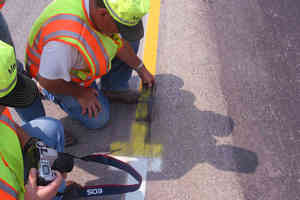 |
Dave Graham, project inspector at Detroit Lakes, checks the performance
of removable reflective tape used to outline the Hwy 336 project work
zone area. Photo by Craig Mittelstadt
|
Innovative efforts by construction project team members to improve highway
work zone safety earned recognition from Mn/DOT’s offices of Construction and
Traffic Engineering. Metro Division and Rochester and Detroit Lakes districts
received work zone safety awards for 2002.
The awards cite accomplishments ranging from effective public information efforts
to using intelligent transportation system technology to manage traffic.
Metro Division earned its award for efforts during rebuilding Hwy 169 (Ferry
Street) from the Anoka-Champlin bridge to Hwy 10 in downtown Anoka. Accomplishments
cited include project updates in local newspapers and radio stations and partnering
with the contractor to ensure prompt action on requests about signing and control
devices.
The project team members included Dan Penn, resident engineer; Charles Cadenhead,
project engineer; W. J. Violett, chief inspector, and Kenneth Pederson, safety
coordinator.
District 4’s reconstruction of Hwy 336 over I-94 near Moorhead received recognition
for daily meetings among the project staff, the State Patrol and the contractor
to review the traffic control plan and the use of reflective experimental reflective
tape to mark the work zone. The tape reflects light in both wet and dry conditions
and peels easily away from the road surface when the project is done.
Jeff Perkins served as resident engineer while Shiloh Wahl served as project
engineer; Dave Graham served as chief inspector and James Tverstal as traffic
control supervisor.
Rochester/District 6 earned its award for using changeable message signs to
update motorists on its I-35 project’s status. Using data supplied by traffic
sensors, the signs provided speed limit and warning signs to manage heavy traffic
through the construction area on the busy freeway.
.jpg) |
A changeable message sign warns motorists to stop during work on I-35
south of Cannon Falls. Photo by Craig Mitteldstadt
|
Team members included Mike Kempinger, resident engineer; Paul Schauer, project
engineer; Jim Duff, chief inspector, and Jeff Rieder, safety coordinator.
"The District 6 project employed a portable system that uses sensors to
determine traffic volume and automatically flashes advisories to motorists,"
said Bill Servatius, work zone safety and training manager, Construction. "This
technology was well-suited for a high-volume, high-speed roadway with a high
potential for serious crashes. We gained valuable experience and are preparing
to use the system on a work zone in the Twin Cities metro area next summer,"
he said.
The award program, Servatius said, underscores the roles that all project team
members have to promote work zone safety.
"The program emphasizes the responsibility contractors, project engineers,
inspectors and traffic supervisors carry to ensure that work zones are as safe
as we can make them and to recognize the efforts they make," he said.
By Craig Wilkins
|
back

|
 |
Hiawatha LRT line moves toward completion |
 |
 |
 |
Construction on the Hiawatha Light Rail Transit Line this winter will
focus on completing stations such as the one at Franklin Avenue in Minneapolis.
Photo by Josh Collins
|
Construction along the Hiawatha light rail transit line will move at a slower
pace during the winter months. The project has moved forward with great speed
since breaking ground in January 2001 and will be two thirds complete by the
end of 2002.
The 2002 construction season began with the laying of track on the main line.
About six miles of main line track are in place now between 1st Avenue N. and
E. 54th Street in Minneapolis as well as about 1.5 miles of track in the yard
and the LRT maintenance facility near Cedar Ave.
"We are right where we need to be going into this winter," said John
Caroon, MN/DOT design-build project manager for the Hiawatha LRT Project. "This
was an important year for this project, and we continue to be on schedule."
"We are right where we need to be going into this winter," said John
Caroon, MN/DOT design-build project manager for the Hiawatha LRT Project. "This
was an important year for this project, and we continue to be on schedule."
During the coming winter, construction activities will focus on areas that
will have minimal impact to motorists. Work will continue on many of the stations
along the route as well as systems work such as setting overhead power poles
and wires.
Construction will begin next year in Bloomington and at the Minneapolis-St.
Paul International Airport, where the Metropolitan Airports Commission has completed
boring twin 1.4-mile tunnels under airport runways that will provide LRT access
to the main and charter terminal stations.
Passenger service on the line will begin between downtown Minneapolis and Fort
Snelling in the spring of 2004. Full operation to the airport and the Mall of
America will start in late 2004.
By Josh Collins
|
back

|
 |
Weiszhaar discusses transportation’s future with county officials |
 |
 |
Acting Commissioner Doug Weiszhaar addressed the annual Association of Minnesota
Counties conference in Duluth on Dec. 9. During his talk, Weiszhaar shared concerns
about the budget deficit, the potential of bonding for transportation needs
and the possible effects of the deficit on local units of government related
to transportation.
Weiszhaar also fielded scores of questions from participants about the impacts
of the state’s anticipated budget deficit on county transportation operations.
More than 200 county commissioners, administrators, engineers and officials
attended the conference.
|
back

|
 |
New Big Lake park and ride lot offers option for commuters |
 |
 |
A new park and ride facility in the heavily traveled Hwy 10 corridor between
St. Cloud and the Twin Cities offers an added opportunity for commuters to carpool.
Commuters can meet at the lot and continue their trip in a shared vehicle.
The facility, which is paved and lighted, with space for 107 vehicles, is located
on the east end of Big Lake and south of Hwy 10. Mn/DOT owns the park and ride
lot and maintains it throughout the year.
"This should be an ideal location for a commuter parking lot with its
proximity to Hwy 10, Hwy 25 and I-94," said Dan Anderson, St. Cloud Maintenance
Area engineer. "Mn/DOT is pleased to provide this facility for carpooling
purposes. We hope folks will take advantage of it."
By Mike Travis
To read about this and other items released to the news media recently, visit
the News and Views page on the Mn/DOT Web site. Some of the most recent news
releases include:
|
back

|
 |
|
 |



